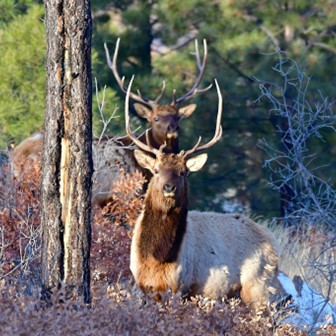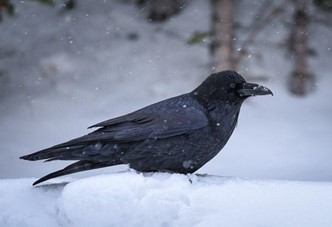
So your traveling to Banff this winter and are hoping to see some Wildlife. While many of the animals in the Rocky Mountains are spending the colder weather indoors (and by the indoors I mean in some form of hibernation), there are still a few residents that stick around and make the best of this winter wonderland.
There are over 56 species of mammals and hundreds of birds and bugs that call Banff and the Rocky Mountains home. These critters have limited choices of how to deal with the seasonal changes that winter brings.
Animals can basically stay and adapt or they can leave.
Of these choices, animals more specifically can choose to migrate, such as the many birds (hummingbirds) and waterfowl (canada goose & loons). Animals that remain here in winter need to adapt or change to conditions. Specific adaptations can include hibernation (ground squirrels, marmots), torpor (grizzly & black bears) or they can remain active through winter, and adapt their behaviour to the cooler temperatures (snowshoe hare & fox).
Of the animals who choose to stay and embrace the ever evolving winter, there are a few that you might see on your Banff adventure!
Meet Banff’s Winter Residents
Elk & Deer

Common in meadows and along forest edges, you might see them near the Banff Townsite seeking some protection from winter's bite. They remain active, feeding on twigs and bark. Even spotting them on the Bow Valley Parkway heading to Johnston Canyon can be common. In late fall and early winter both these members of the deer family are either beginning their rut (deer) or finishing up the rutting season (elk) and can be found in lower montane elevations.
Big Horn Sheep

Big Horn Sheep are another hoofed mammal that are known to come down to lower elevations while seeking grasses (60% of diet) and warmth. In early December the males (rams) can still be seen with female groups. They will eventually leave these groups as winter proceeds.
Spotting these herds of various sizes can be rewarding and exciting. You can find them along Bow Valley Parkway or on the road up to Sunshine Meadows.
Wolves

While considered more elusive than their cousin the coyote, their tracks are often visible in the snow. Wolves are more active in the winter, they hunt and eat big game especially when smaller mammals are hard to find or are hibernating. They have the coat to protect themselves throughout the cold months. Though seeing them can be difficult, look for their tracks on the Bow Valley Parkway, near townsite trails in Lake Louise and Banff.
Ravens
 These intelligent scavengers use the winter to their advantage. Locating frozen carcasses and scraps near human areas is common for these birds. Their dense plumage and thick downy undercoats help insulate them. Ravens will seek out shelter and roosting spots in tree canopies, so are often heard and then spotted in many areas through Banff National Park. Ravens mate for life and stay year-round to protect areas that they value as food sources. How many Ravens will you see?
These intelligent scavengers use the winter to their advantage. Locating frozen carcasses and scraps near human areas is common for these birds. Their dense plumage and thick downy undercoats help insulate them. Ravens will seek out shelter and roosting spots in tree canopies, so are often heard and then spotted in many areas through Banff National Park. Ravens mate for life and stay year-round to protect areas that they value as food sources. How many Ravens will you see?
Magpies

Although considered a nuisance at times and overlooked, Black-billed magpies make their home in the Canadian Rockies year-round. The birds are highly social “hack-hack” and stay in small flocks usually in and around Banff town, Jasper and lower elevations. They will adjust their diet in winter, eating mostly berries, seeds and scavenge on roadsides. They will often form symbiotic relationships with larger animals of the deer family and will travel close by.
With snow blanketing the ground, spotting fresh tracks becomes part of the adventure too . Whether you’re searching for Banff’s winter residents or just exploring trail, remember to be prepared, make noise, be aware of your surroundings and pack appropriately.
We invite you to check out the many places Banff National Parks has to offer in the Winter. For inquiries on how to make the most of your trip, contact us, let us show you the many wonders of the season!
By Scott Horsley